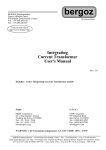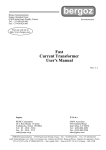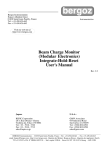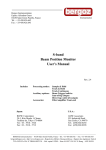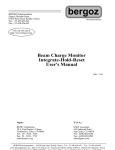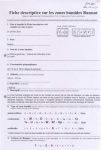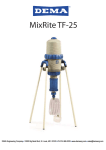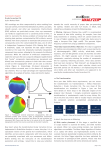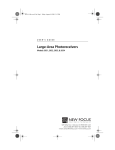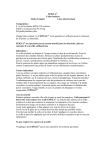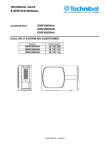Download BLM Manual
Transcript
Bergoz Instrumentation Espace Allondon Ouest 01630 Saint Genis Pouilly, France Tel.: +33-450.426.642 Fax: +33-450.426.643 bergoz Instrumentation Visit our web site at http://www.bergoz.com Beam Loss Monitor User’s Manual Manual rev. 1.6 Japan: U.S.A.: REPIC Corporation 28-3, Kita Otsuka 1-Chome Toshima-ku, Tokyo 170-0004 Tel.: 03 - 3918 - 5326 Fax: 03 - 3918 - 5712 Email: [email protected] GMW P.O. Box 2578 Redwood City, CA 94064 Tel.: (650) 802-8292 Fax: (650) 802-8298 Email: [email protected] BERGOZ Instrumentation - 01630 Saint Genis Pouilly, France - Tel.: +33-450.426.642 - Fax: +33-450.426.643 email: [email protected] - http://www.bergoz.com - Registre des Métiers: Bourg-en-Bresse - Registre des ingénieurs: Zurich TVA-VAT-IVA-USt. Nº FR88414997130 - Sàrl. capital 152K - Siren 414 997 130 R.C.S. Bourg - APE 332B Bergoz Instrumentation 01630 Saint Genis Pouilly, France Tel.: +33-450.426.642 Fax: +33-450.426.643 SUMMARY INITIAL INSPECTION ........................................................... WARRANTY ......................................................................... ASSISTANCE ..................................................................... SERVICE & RETURN PROCEDURES .......................................... YOU JUST RECEIVED YOUR BLM ............................................ QUICK CHECK ................................................................... OPERATING PRINCIPLE ...................................................... Detector type ............................................................. Signal Processing ......................................................... Efficiency of the detector ................................................ Dynamic range ........................................................... Radiation resistance ....................................................... CALIBRATION ..................................................................... On-the-bench calibration ................................................. On-line calibration ........................................................ CHANGING THE PIN-DIODES ................................................. COMPTON ELECTRONS SHIELD ............................................... INSTALLATION ................................................................ Mechanical mounting ....................................................... Mounting holes ............................................................ Connecting the BLM ...................................................... Counting the hits .......................................................... SPECIFICATIONS ................................................................ ACKNOWLEDGEMENTS ....................................................... Beam Loss Monitor User’s Manual Page 2 Page 3 3 3 3 4 4 6 6 6 6 7 7 7 7 7 8 9 10 10 11 11 11 12 12 Bergoz Instrumentation 01630 Saint Genis Pouilly, France Tel.: +33-450.426.642 Fax: +33-450.426.643 Beam Loss Monitor User’s Manual Page 3 INITIAL INSPECTION It is recommended that the shipment be inspected immediately upon delivery. If it is damaged in any way, contact Bergoz Instrumentation or your local distributor. The content of the shipment should be compared to the items listed on the invoice. Any discrepancy should be notified to Bergoz Instrumentation or its local distributor immediately. Unless promptly notified, Bergoz Instrumentation will not be responsible for such discrepancies.. WARRANTY Bergoz Instrumentation warrants its beam current monitors to operate within specifications under normal use for a period of 12 months from the date of shipment. Spares, repairs and replacement parts are warranted for 90 days. Products not manufactured by Bergoz Instrumentation are covered solely by the warranty of the original manufacturer. In exercising this warranty, Bergoz Instrumentation will repair, or at its option, replace any product returned to Bergoz Instrumentation or its local distributor within the warranty period, provided that the warrantor's examination discloses that the product is defective due to workmanship or materials and that the defect has not been caused by misuse, neglect, accident or abnormal conditions or operations. Damages caused by ionizing radiations are specifically excluded from the warranty. Bergoz Instrumentation and its local distributors shall not be responsible for any consequential, incidental or special damages. ASSISTANCE Assistance in installation, use or calibration of Bergoz Instrumentation beam current monitors is available from Bergoz Instrumentation, 01630 Saint Genis Pouilly, France. It is recommended to send a detailed description of the problem by fax. SERVICE PROCEDURE Products requiring maintenance should be returned to Bergoz Instrumentation or its local distributor. Bergoz Instrumentation will repair or replace any product under warranty at no charge. The purchaser is only responsible for transportation charges. For products in need of repair after the warranty period, the customer must provide a purchase order before repairs can be initiated. Bergoz Instrumentation can issue fixed price quotations for most repairs. However, depending on the damage, it may be necessary to return the equipment to Bergoz Instrumentation to assess the cost of repair. RETURN PROCEDURE All products returned for repair should include a detailed description of the defect or failure, name and fax number of the user. Contact Bergoz Instrumentation or your local distributor to determine where to return the product. Returns must be notified by fax prior to shipment. Return should be made prepaid. Bergoz Instrumentation will not accept freight-collect shipment. Shipment should be made via Federal Express or United Parcel Service. Within Europe, the transportation service offered by the Post Offices "EMS" (Chronopost, Datapost, etc.) can be used. The delivery charges or customs clearance charges arising from the use of other carriers will be charged to the customer. Bergoz Instrumentation 01630 Saint Genis Pouilly, France Tel.: +33-450.426.642 Fax: +33-450.426.643 Beam Loss Monitor User’s Manual Page 4 YOU JUST RECEIVED YOUR BLM.... The copper shield may be soldered onto the printed circuit board... or it may be loose. Some units are delivered with a loose (unsoldered) copper shield to allow the user to change the model of PIN-diode. Verify which BLM model you have The model of BLM is marked on the copper shield. Only one model is currently offered. It features a RED dot on the shield. It indicates: • BLM equipped with "BPW34" PIN-diodes from Siemens featuring an active area of 7.34 mm2 Older models no longer offered may have a BLUE dot on the shield: • BLM-XL, equipped with "S2662" from Hamamatsu featuring an active area of 150 mm2 QUICK CHECK You can check immediately that your BLM is working. To check the spurious count rate in each channel, this is what you need: • • • • Beam Loss Monitor Oscilloscope, 1 channel, 100 MHz bandwidth Power supplies: ±5V, +24V Resistor 4.7 kΩ 1/8W To check the actual count rate from MIPs (minimum ionizing particles), you need: • High energy β- source BEAM LOSS MONITOR bergoz P2 P1 2 4 6 8 10 13579 Connect the power supplies: Ground ................................................Pin 1 + 5V...................................................Pin 2 – 5V................................................... Pin 4 + 24V................................................. Pin 6 Pin# Function 1.................. Ground 2.................. + 5V 3.................. n/c 4.................. - 5V 5.................. Enable B 6.................. +24V 7.................. n/c 8.................. Ground 9.................. Enable A 10................ Output Bergoz Instrumentation 01630 Saint Genis Pouilly, France Tel.: +33-450.426.642 Fax: +33-450.426.643 Beam Loss Monitor User’s Manual Page 5 QUICK CHECK (Cont’d) Connect the oscilloscope: Output..................................................Pin 10 Ground................................................ Pin 8 To display the spurious counts of each channel separately, the opposite channel must be enabled (as if it had received a hit at the same time): Connect the +5V supply, via a 4.7KΩ to......... Pin 5 (Enable channel B) The oscilloscope displays the spurious counts in channel A. Alternatively, Connect the +5V supply, via a 4.7KΩ to......... Pin 9 (Enable channel A) The oscilloscope displays the spurious counts in channel B. Both waveforms look like this: Output pulse Note: The copper shield must cover the BLM, even if it is not soldered. The minimum spurious count is obtained when the copper shield is soldered all around the board. To display the counts from MIPs (minimum ionizing particles): Do not enable Channel A or Channel B (pins 5 and 9). Bring a high-energy β- source and the BLM closer to each other, observe the increase in the count rate. Bergoz Instrumentation 01630 Saint Genis Pouilly, France Tel.: +33-450.426.642 Fax: +33-450.426.643 Beam Loss Monitor User’s Manual Page 6 OPERATING PRINCIPLE Detector type The detector is sensitive to MIPs (minimum ionizing particles) produced when an accelerated particle hits the wall of the vacuum chamber. Refer to Annex I: “Electron Beam Loss Monitor” by W. Bialowons, F. Ridoutt and K. Wittenburg for the mechanism of beam loss in FODO structures due to accelerated particles inelastic scattering on residual molecules nuclei. The detector is composed of two PIN-diodes mounted face to face to form a 2-channel coincidence detector. +Bias MIP Photon <100ns 100um Coincidence +Bias Signal processing When an ionizing particle hits a PIN-diode, an electric charge is produced. A bias voltage allows collection of this charge. It is amplified to a level high enough for conventional logic. An AND-gate detects the coincidence of pulses from the two PIN-diodes. MIPs cause ionizations in both PIN-diodes, a coincidence occurs and an output pulse is generated. Photons do not cause ionization in both PIN-diodes. So, the coincidence circuit does not produce a pulse for photons. The amplification gain of each channel is adjusted with a potentiometer. Efficiency of the detector Overall, MIPs are detected with an efficiency > 30 %. See Annex III: “Radiation Resistance of Beam Loss Monitor” by K. Wehrheim and K. Wittenburg. The size of the PIN-diodes mounted on the circuit determines the detector’s solid angle. The coincidence scheme rejects very effectively the spurious noise from each channel to a figure well below 1 count/s. The channel gains can be adjusted to obtain negligible spurious count rates: < 0.1 count/min. See Annex II “A Beam Loss Monitor for HERA” by S. Schlögl and K. Wittenburg. It rejects equally effectively the X-ray background typical of electron/positron storage rings. Bergoz Instrumentation 01630 Saint Genis Pouilly, France Tel.: +33-450.426.642 Fax: +33-450.426.643 Beam Loss Monitor User’s Manual Page 7 Dynamic range It is determined by the spurious noise of the detector and the maximum count rate. It exceeds 108. The spurious noise, in the absence of any background, is well below 1 count/s. In the presence of an X-ray background, the BLM must be shielded by 3 cm of lead to maintain the spurious count rate below 1 count/s. Without a lead shield, the spurious count rate has been observed on HERA to reach 100 counts/s. The detector recovers 100 ns after a hit, leading to 10 MHz maximum count rate. Radiation resistance Prototypes similar to production units were tested at DESY for radiation hardness. The unit under test was still working after 108 Rads dose (!). See Annex III: “Radiation Resistance of Beam Loss Monitor” by K. Wehrheim and K. Wittenburg. CALIBRATION BLM circuits are calibrated ex-factory for a spurious count rate of 10 kHz ±800 Hz. Calibration / Recalibration is needed when the PIN-diodes are changed for another type (larger, smaller). Calibration checks can be performed on line. On-the-bench calibration To calibrate the spurious count rate, power up the BLM. Connect a frequency counter on the output. BEAM LOSS MONITOR bergoz P2 P1 2 4 6 8 10 13579 Pin# Enable A Function 1.................. Ground 2.................. + 5V 3.................. n/c 4.................. - 5V 5.................. Enable B 6.................. +24V 7.................. n/c 8.................. Ground 9.................. Enable A 10................ Output + Bias Channel A P1 P2 Channel B + Bias Enable B To calibrate channel A, apply +5V via a 4.7kΩ resistor to “Enable B” pin 5. Adjust potentiometer P1 for 10 kHz output. To calibrate channel B, apply +5V via a 4.7kΩ resistor to “Enable A” pin 9. Adjust potentiometer P2 for 10 kHz output. On-line calibration check Apply a voltage ≥ 1V alternately to Enable A (pin 9) and Enable B (pin 5). Observe the count rate to be 10 kHz ±800 Hz. Enable A, resp. Enable B, draws 120 µA from 1 V. Bergoz Instrumentation 01630 Saint Genis Pouilly, France Tel.: +33-450.426.642 Fax: +33-450.426.643 Beam Loss Monitor User’s Manual Page 8 CHANGING THE PIN-DIODES PIN-diodes can be changed by the user for a larger-area model. Two similar diodes are required for each BLM unit. Operations • Make sure the BLM works properly before modification: See QUICK CHECK, in this manual. • Remove the printed circuit from the ABS plastic bucket: pull gently on the copper shield. • Desolder the copper shield and remove it. • Desolder the PIN-diodes and remove them. • Install the new PIN-diodes. They should be facing each other. Their active areas should overlap ! Beware of the PIN diodes polarity. There are two possible configurations with the correct polarity: – + – + + – + – P2 P1 P2 P1 Note the common cathodes. WARNING: Installing PIN-diodes with the wrong polarity voids the warranty. • Execute a QUICK CHECK before the copper shield is resoldered. • Re-solder the copper shield. Make sure the copper shield does not touch the PIN-diodes leads ! If needed, use polyvinyl adhesive tape to isolate the inside of the shield. • Re-calibrate the BLM. See CALIBRATION in this manual. Please note: large area PIN-diodes have more dark current, so the span of P1 and P2 covers a wider range and the adjustment of P1/P2 on 10 kHz dark current is more “touchy”. Bergoz Instrumentation 01630 Saint Genis Pouilly, France Tel.: +33-450.426.642 Fax: +33-450.426.643 Beam Loss Monitor User’s Manual Page 9 COMPTON ELECTRONS SHIELD Production of Compton electrons in the BLM PIN-photodiodes has been observed on very-high energy leptons accelerators (HERA-e, LEP). The consequence of Compton electrons production in one PIN-diode is that it may cause ionization in the other PIN-diode. As a result, the PIN-diodes produce pulses which are coincident and the BLM gives an output pulse. On very high energy leptons accelerators, these Compton electrons increase the background noise significantly1. The increase in background noise reduces the BLM useful dynamic range. A way the avoid this problem was sought. It was proposed2 to install a shield between the two PIN-photodiodes. This proposed improvement was sucessfully tested at both LEP and HERA: It reduces the Compton electron-induced noise significantly. The shield is made in 200 µm thick copper. It is grounded via a high value resistor to prevent static charge build-up. This sceen is not proposed as a catalogue option, because it concerns very few accelerators only. Those BLM units where the shield is installed are identified by part number : BLM/B-.... 1 Improvement in the useful dynamic range of the LEP Beam Loss Monitor, T.Spickermann, CERN, and K.Wittenburg, DESY, to be published 2 Private communication, K.Wittenburg Bergoz Instrumentation 01630 Saint Genis Pouilly, France Tel.: +33-450.426.642 Fax: +33-450.426.643 Beam Loss Monitor User’s Manual Page 10 INSTALLATION Mechanical mounting The BLM must be oriented facing the particles to be detected: 4.5±0.2 4.65 Detector front PIN-photodiodes BEAM LOSS MONITOR bergoz P2 P1 2 4 6 8 10 BLM-XS Position of PIN-photodiodes relative to inner wall of brass shield Dimensions in mm Shield thickness: 0.40 ± 0.02 mm Shield material: Brass Face-to-face PIN-photodiodes: BPW 34B Active area: 7.34 mm2 in plane perpendicular to printed circuit 13579 Generally, mathematical simulation will indicate where beam loss is most likely to occur (See Annex I for FODO structure beam loss). BLMs will generally be placed with the front applied against the magnets. The BLMs can be screwed on brackets with two M3 screws. M3 screws will gently make their way into the Ø2.8mm holes of the ABS plastic. It is however preferable to attach the BLM with adhesive tape. Tape made out of fiber glass with rubberbased adhesive have excellent radiation and heat resistance (manufactured by Scotch 3M, type 27). Bergoz Instrumentation 01630 Saint Genis Pouilly, France Tel.: +33-450.426.642 Fax: +33-450.426.643 Beam Loss Monitor User’s Manual Page 11 Mounting holes 33.5 mm 30 mm The BLM does not require additional protection. Connecting the BLMs Connection of the BLMs to a counting station depends very much on the physical layout of the accelerator. On large accelerators, a solution consists in clustering together a small number of BLMs. Each BLM connects to the cluster center by a flat cable. On the BLM-side, the flat cable is terminated by an HE10 10pin female connector such as Scotch 3M, type 3473-6000. The cluster is either powered locally, or local voltage regulation is provided. The output signal is brought from each BLM to a centralized or decentralized counting room by a 50Ω coax cable. A thin (and short) coax cable should preferably be used as feeder on the BLM-side. It is attached to pin 10 of the HE10 connector, and ground is taken from pin 8. The short coax feeder connects to the main coax with any 50Ω connector. At DESY, RG-59 75Ω coax cables are used for distances up to 100 meters without problems (K. Wittenburg, private communication, Febr. 9, 1995). For cables longer than 100 meters, a small amplifier is added in front of the scaler. It is recommended to test the actual cable to be used with the BLM and the scaler. The very large variety of cables and scalers on the market does not allow Bergoz Instrumentation to guarantee safe operation with a given length of cable. Counting the hits Scalers accepting TTL pulses must be used. Laboratory testing can be made using a frequency counter. Bergoz Instrumentation 01630 Saint Genis Pouilly, France Tel.: +33-450.426.642 Fax: +33-450.426.643 Beam Loss Monitor User’s Manual Page 12 SPECIFICATIONS Minimum ionizing particle detection efficiency PIN-photodiode surface Spurious count rate Maximum count rate Count rate @ 6x105 Rad/yr background SR Same with 3 cm lead shielding Output Cable driving capability Mating connector Calibration check commands Enable A Enable B Power supply +5V -5V +24V Size > 30% 7,34 mm2 < 0.1 Hz > 10 MHz ≈ 100 Hz ≈ 1 Hz positive TTL 50Ω > 200m RG213 10-pin HE10 female ≥ 1V 120 µA ≥ 1V 120 µA < 50mA, typ. 45mA < 80mA, typ. 72mA < 10mA, typ. 4 mA with BPW34B PIN-diodes 69 x 34 x 18 mm ACKNOWLEDGEMENTS The conceptual design of this Beam Loss Monitor is the work of several individuals at DESY-PKTR, over many years. I wish to thank them all here for their unique contribution to a very effective beam diagnostic tool, particularly Kay Wittenburg who has been the driving force all along. The contribution of Bergoz Instrumentation has been to redesign the circuit to make it smaller by using surface mounted components, and more economical to assemble. Minor design changes were made at that time. DESY granted Bergoz Instrumentation a licence to use the original concept of the PIN-Photodiodes Beam Loss Monitor, to further develop it, to build and sell instruments based on this principle. Saint Genis Pouilly, last revised February 2001













